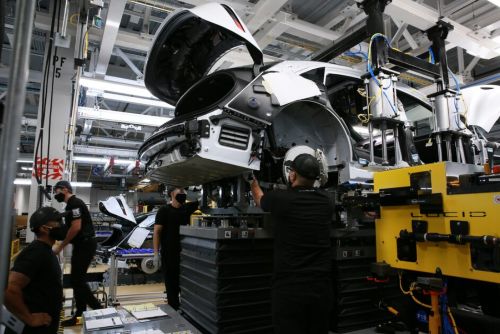

Factories that once symbolized resilience and prosperity are shedding workers at a pace unseen since the last major downturn.

By Matthew A. McIntosh
Public Historian
Brewminate
Introduction: A New Chapter in an Old Story
For decades, the decline of manufacturing jobs in the United States seemed like a slow burn. Factories closed, automation spread, and global trade reshaped industries that had once defined American life. Yet since Donald Trump returned to office in January 2025, that gradual decline has taken on a sharper edge. Recent downturns in the broader economy have accelerated job losses, and many economists already describe the current moment as the early stage of a recession.
The symbolic weight of factory work has always carried political resonance. Trump built much of his earlier political appeal around promises to restore America’s industrial strength. The renewed fall of manufacturing jobs under his second presidency complicates that promise, raising questions about whether the U.S. can meaningfully rebuild its industrial base in the midst of economic instability.
Numbers That Tell the Story
Early 2025 brought a steady erosion of factory employment, with government labor reports showing monthly declines in manufacturing payrolls. The losses, while uneven across sectors, have been most visible in durable goods production, from automotive suppliers to steel and heavy machinery.
By midyear, tens of thousands of jobs had disappeared. Compared to modest gains in the early 2020s, the reversal was stark. Economists cite both cyclical pressures and structural weaknesses. Consumer demand slowed, global supply chains remained volatile, and businesses pulled back on investment amid uncertainty about interest rates and trade policy.
The result is an industry once seen as the backbone of middle-class stability now facing another sharp contraction.
Recessionary Winds and Worker Anxiety
Signs of a broader economic slowdown are everywhere. Rising unemployment, slowing GDP growth, and contracting consumer spending have converged to create conditions many describe as a recession already in motion. In manufacturing-heavy regions, the pain is immediate.
Communities in the Midwest report layoffs at auto plants and suppliers. Small towns reliant on a single factory see ripple effects spread quickly: local diners empty, tax revenues shrink, and families begin to cut back on expenses. The anxiety is not abstract but woven into daily choices about groceries, rent, and healthcare.
For workers who had hoped that Trump’s renewed emphasis on “America First” economic policy might revive local industry, the contrast is jarring. Campaign promises of a manufacturing renaissance have given way to the reality of pink slips and shuttered shop floors.
Global Shocks and Old Fault Lines
The domestic downturn does not exist in isolation. Global manufacturing itself has slowed, particularly in China and Europe, where recessions or near-recessions are constraining demand for U.S. exports. Trade tensions have resurfaced, adding friction to supply chains already strained by years of instability.
At home, automation and efficiency gains continue to reduce the need for large factory workforces. Even companies committed to reshoring or expanding U.S. production rely increasingly on robotics and AI-driven systems, which keep output steady while eliminating human jobs.
This combination of global contraction and technological change exposes old vulnerabilities. Once again, American manufacturing workers find themselves on the losing end of forces they cannot control.
Social and Political Fallout
The decline of manufacturing jobs has always been more than economic. It carries social consequences that reverberate through communities. Stable wages once tied to factory work supported schools, local governments, and small businesses. Their loss feeds cycles of instability, including declining homeownership rates and rising personal debt.
Politically, the narrative is fraught. Trump’s supporters often view him as the last defender of American industry, yet the renewed job losses under his presidency risk undermining that perception. Opponents, meanwhile, argue that his policies, from tariff brinkmanship to cuts in federal investment programs, have worsened the situation rather than improved it.
The tension highlights how manufacturing jobs remain a cultural touchstone, even as their actual share of the labor force continues to shrink.
Searching for Stability
As 2025 progresses, policymakers and business leaders confront familiar questions. Can industrial policy blunt the effects of a global slowdown? Will targeted investments in infrastructure, semiconductors, or clean energy generate enough high-wage factory jobs to make a meaningful difference?
For now, the answers remain uncertain. What is clear is that the United States has entered a new phase of its long struggle with industrial decline. The promises of revival ring hollow when measured against the lived experience of workers confronting layoffs, shrinking opportunities, and the unease of recession.
Conclusion: A Nation in the Balance
The story of American manufacturing is once again at a crossroads. Factories that once symbolized resilience and prosperity are shedding workers at a pace unseen since the last major downturn. The stakes are not just economic but cultural, cutting into the identity of communities that long defined themselves through industrial labor. The decline since January 2025 underscores the fragility of promises to “bring jobs back.” It also forces a reckoning with larger questions about what kind of economy the United States is building, and whether it can sustain the dignity and stability that factory work once guaranteed.
Originally published by Brewminate, 09.08.2025, under the terms of a Creative Commons Attribution-NonCommercial-NoDerivatives 4.0 International license.


